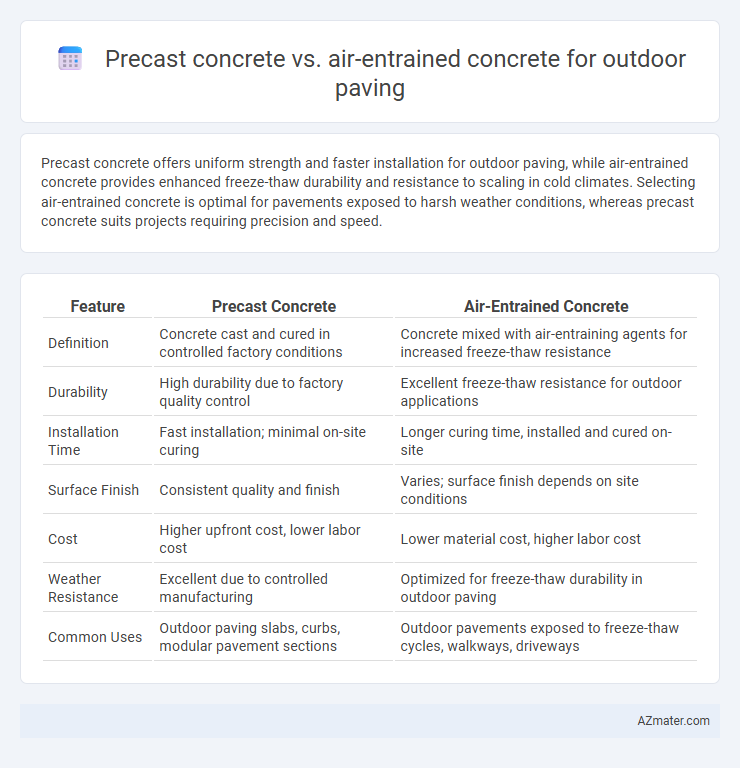Precast concrete offers uniform strength and faster installation for outdoor paving, while air-entrained concrete provides enhanced freeze-thaw durability and resistance to scaling in cold climates. Selecting air-entrained concrete is optimal for pavements exposed to harsh weather conditions, whereas precast concrete suits projects requiring precision and speed.
Table of Comparison
| Feature | Precast Concrete | Air-Entrained Concrete |
|---|---|---|
| Definition | Concrete cast and cured in controlled factory conditions | Concrete mixed with air-entraining agents for increased freeze-thaw resistance |
| Durability | High durability due to factory quality control | Excellent freeze-thaw resistance for outdoor applications |
| Installation Time | Fast installation; minimal on-site curing | Longer curing time, installed and cured on-site |
| Surface Finish | Consistent quality and finish | Varies; surface finish depends on site conditions |
| Cost | Higher upfront cost, lower labor cost | Lower material cost, higher labor cost |
| Weather Resistance | Excellent due to controlled manufacturing | Optimized for freeze-thaw durability in outdoor paving |
| Common Uses | Outdoor paving slabs, curbs, modular pavement sections | Outdoor pavements exposed to freeze-thaw cycles, walkways, driveways |
Introduction to Outdoor Paving Materials
Precast concrete offers high durability and consistent quality, making it ideal for outdoor paving in high-traffic areas, while air-entrained concrete enhances freeze-thaw resistance due to its microscopic air bubbles, improving performance in cold climates. Both materials provide excellent structural strength, but air-entrained concrete specifically prevents cracking from moisture expansion and contraction. Selection depends on environmental conditions and load requirements, with precast concrete favored for rapid installation and air-entrained concrete preferred for frost-prone regions.
What is Precast Concrete?
Precast concrete is a type of concrete that is cast and cured in controlled factory environments before being transported to the installation site, ensuring consistent quality and strength. It offers high durability and precision, making it ideal for outdoor paving applications where uniformity and rapid installation are essential. Compared to air-entrained concrete, precast concrete provides greater resistance to wear and environmental factors due to its controlled production process and optimized reinforcement.
What is Air-Entrained Concrete?
Air-entrained concrete contains microscopic air bubbles introduced during mixing, which improve durability and resistance to freeze-thaw cycles, making it ideal for outdoor paving in cold climates. Precast concrete, manufactured off-site and then transported, offers precise quality control and faster installation but may lack the enhanced freeze-thaw protection of air-entrained mixes. Choosing air-entrained concrete for outdoor paving ensures longer-lasting surfaces in environments exposed to moisture and temperature fluctuations.
Key Differences Between Precast and Air-Entrained Concrete
Precast concrete for outdoor paving offers precise control over shape, size, and surface finish, enhancing durability and aesthetic appeal with factory-made consistency. Air-entrained concrete incorporates microscopic air bubbles to improve resistance to freeze-thaw cycles, reducing cracking and scaling in colder climates. Key differences include the manufacturing process--precast being produced off-site for uniformity versus air-entrained concrete mixed on-site for enhanced freeze-thaw durability--and their suitability depending on environmental exposure and installation requirements.
Durability in Freeze-Thaw Conditions
Precast concrete offers superior durability in freeze-thaw conditions due to its controlled manufacturing environment, allowing for precise air-void distribution and high compressive strength. Air-entrained concrete enhances freeze-thaw resistance by incorporating microscopic air bubbles that relieve internal pressure from freezing water, reducing spalling and cracking on outdoor pavements. For outdoor paving subject to cyclic freezing and thawing, selecting precast elements with optimized air-entrainment ensures long-lasting performance and minimal maintenance.
Installation Process Comparison
Precast concrete offers a streamlined installation process with factory-controlled quality, allowing quick placement of uniform panels or slabs on properly prepared subbases, minimizing onsite adjustments. Air-entrained concrete, mixed and poured onsite, requires careful curing and controlled conditions to achieve the desired durability and freeze-thaw resistance, often extending installation time due to curing requirements. The precast method reduces weather-related delays, while air-entrained concrete provides flexibility in shape and size but demands meticulous timing and skilled labor for optimal performance in outdoor paving.
Maintenance Requirements
Precast concrete offers minimal maintenance due to factory-controlled production, ensuring uniform strength and durability that resists cracking and weathering from outdoor elements. Air-entrained concrete incorporates microscopic air bubbles to enhance resistance to freeze-thaw cycles, reducing surface scaling and the need for frequent repairs in climates with harsh winters. Regular sealing is recommended for both, but air-entrained concrete typically requires more consistent upkeep in terms of surface treatment to maintain its protective air-void structure.
Cost Analysis and Efficiency
Precast concrete offers lower labor costs and faster installation times compared to air-entrained concrete, making it more cost-efficient for large-scale outdoor paving projects. Air-entrained concrete, while more expensive initially due to additive costs, provides superior freeze-thaw durability and reduces maintenance expenses in cold climates. Evaluating life-cycle cost and local weather conditions is crucial for determining the optimal choice between precast and air-entrained concrete.
Environmental Impact and Sustainability
Precast concrete for outdoor paving offers reduced waste and energy-efficient manufacturing processes, contributing to lower carbon emissions compared to traditional pouring methods. Air-entrained concrete enhances durability by improving resistance to freeze-thaw cycles, which extends pavement lifespan and reduces the frequency of repairs, thus minimizing resource consumption over time. Both materials support sustainable construction goals, with precast concrete emphasizing efficient production and air-entrained concrete focusing on long-term environmental resilience.
Choosing the Right Concrete for Outdoor Paving
Precast concrete offers consistent strength and uniformity, making it ideal for outdoor paving that requires durability and precise dimensions, while air-entrained concrete enhances freeze-thaw resistance essential for climates experiencing frequent temperature fluctuations. Choosing the right concrete involves evaluating site conditions, load requirements, and environmental exposure to ensure longevity and performance. Air-entrainment improves concrete's resistance to scaling and cracking in freeze-thaw cycles, whereas precast units reduce on-site labor and curing time, optimizing project efficiency.

Infographic: Precast concrete vs Air-entrained concrete for Outdoor paving
 azmater.com
azmater.com